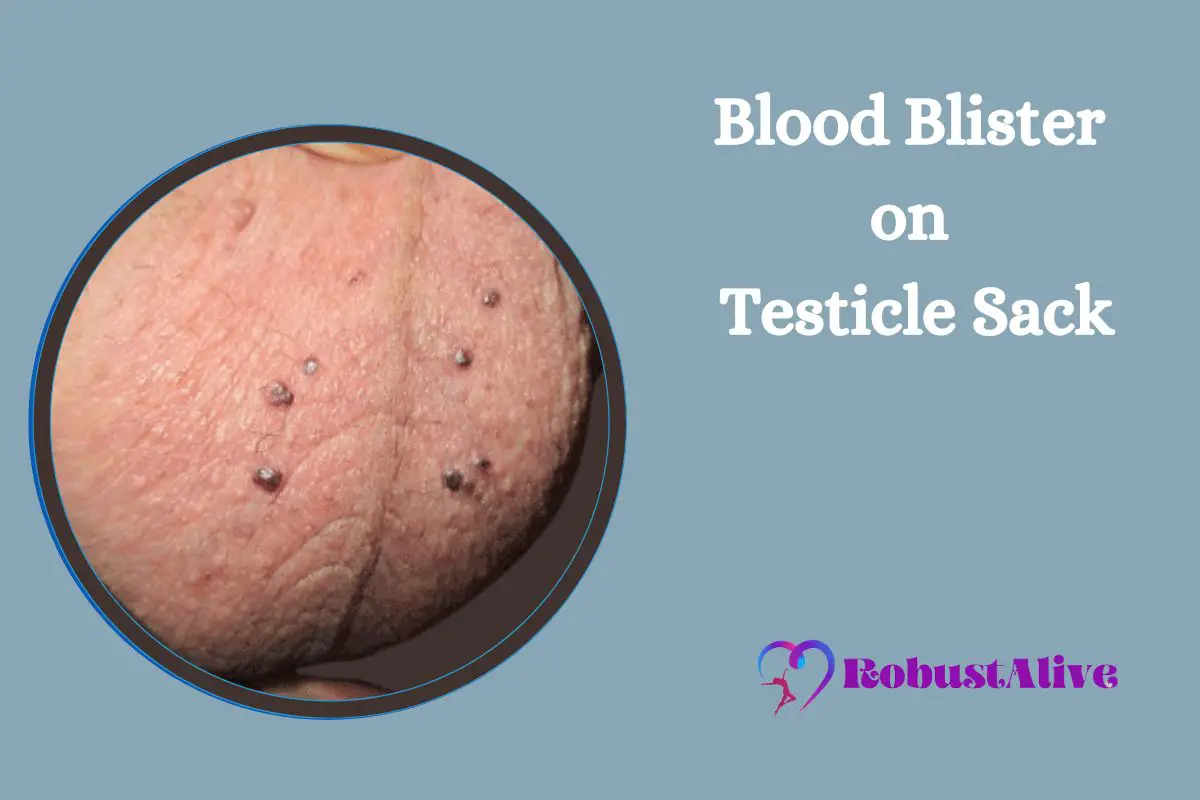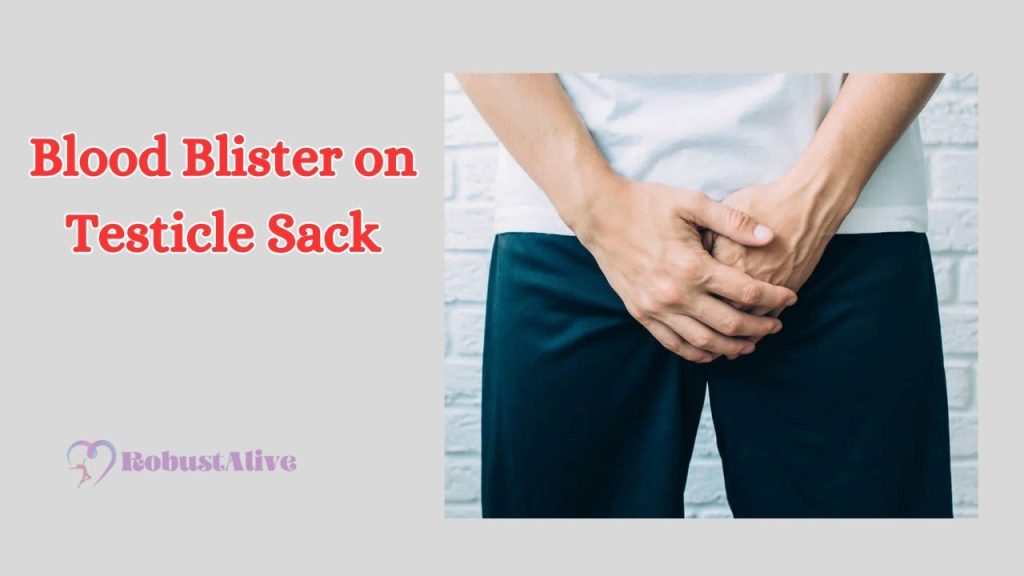Blood Blister on Testicle Sack – Causes, Symptoms, and Treatment

Discovering a blood blister on the testicle sack can be a distressing and concerning experience for any individual. The testicles are vital organs in the male reproductive system, and any abnormality in this area may lead to feelings of anxiety or fear.
So, what causes blood blisters on the testicle sack, and how should it be treated?
Blood blisters on the testicle sack can occur due to skin conditions, injuries, or infections. They might go away on their own, but if they are painful, persist, or bleed often, it’s essential to seek medical help. Taking care of hygiene and avoiding scratching is advised. Medical treatments such as cryotherapy or surgery may be necessary in severe cases.
In this article, we will delve into the causes, symptoms, diagnosis, and treatment options for blood blisters on the testicle sack.
Are Blood Blisters On Testicle Sack Concerning?

Blood blisters on the testicle sack can be alarming, but they are typically harmless. However, it is important to pay attention to any changes in size, color, or symptoms associated with the blisters. If the blood blisters become painful, frequently bleed, or show signs of infection, it is advisable to seek medical attention for proper diagnosis and treatment.
What Causes Blood Blisters On Testicle Sack?
Several factors can contribute to the development of blood blisters on the testicle sack. Some common causes include:
- Angiokeratoma: This condition manifests as red or purple bumps on the scrotum, which can bleed if scratched.
- Trauma: Physical injury or trauma to the testicles, such as a direct blow, can cause blood vessels to rupture and result in blood blisters.
- Friction: Excessive rubbing or friction between the testicles and clothing during physical activities or sports can lead to blood blister formation.
- Varicocele: Varicoceles are enlarged veins in the scrotum that can cause blood to pool, potentially leading to blood blisters.
- Herpes: Herpes is a viral disease that can cause red bumps on the scrotal sac, potentially leading to blood blisters.
- Prostate Enlargement: Enlargement of the prostate gland can result in blood blisters on the scrotum, often accompanied by a lump above the scrotum.
- Folliculitis: This type of acne on the scrotum occurs when hair strands get trapped in the follicles and become infected.
Blood blisters on the scrotum can also be associated with venous hypertension, chickenpox, shingles, deficiencies in vitamins B12 and C, as well as allergic reactions, heat, and cold.
Read More: Square Butt
Identification And Symptoms
Identifying blood blisters on the testicle sack is crucial for proper understanding and timely intervention. The following symptoms may be observed:
- Red or purple bumps on the scrotum
- Blisters that can bleed if scratched
- Pain or discomfort in the affected area
- Lump or swelling above the scrotum
- Signs of infection, such as warmth, redness, or pus
In many cases, blood blisters on the testicle sack may resolve on their own without specific treatment. However, if the blisters are painful, frequently bleed, or persist for an extended period, medical attention should be sought to determine the underlying cause and appropriate course of action.
How is Blood Blister on Testicle Sack Diagnosed?

Graphics Credit: Robustalive.com
A healthcare professional will conduct a thorough examination of the affected area to diagnose the blood blister on the testicle sack. They may inquire about the symptoms, medical history, and possible contributing factors. In some cases, additional tests, such as blood tests or imaging studies, may be recommended to rule out underlying conditions.
How is This Condition Treated?
Treatment for blood blisters on the testicles depends on the underlying cause and the severity of the symptoms. Here is an in-depth explanation of the treatment options:
Self-Care and Home Remedies
In some cases, blood blisters on the testicles may resolve on their own without any treatment. However, there are self-care measures and home remedies that can help alleviate symptoms and promote healing:
- Keep the area clean: Maintain good hygiene by washing the affected area with mild soap and warm water. Pat the area dry gently.
- Please avoid scratching or popping: It is important not to scratch or pop the blood blisters, as this can lead to infection or further irritation.
- Wear loose-fitting underwear: Choose underwear made of breathable fabric to prevent friction and irritation on the affected area.
- Over-the-counter pain relievers: If the blood blisters are causing discomfort or pain, over-the-counter pain relievers like ibuprofen or acetaminophen can help provide temporary relief.
Also Read: Plasma Pen Gone Wrong
Medical Treatments
If the blood blisters on the testicles are persistent, cause significant discomfort, or are associated with an underlying medical condition, medical treatments may be necessary. It is important to consult a healthcare professional for proper diagnosis and treatment options. Some medical treatments include:
- Cryotherapy: This procedure involves freezing the blood blisters with liquid nitrogen to destroy the abnormal blood vessels. Cryotherapy can be effective in removing blood blisters but may require multiple sessions.
- Electrocauterization: In this procedure, an electric current is used to cauterize or burn off the blood blisters. It helps in sealing the blood vessels and preventing further bleeding.
- Laser therapy: Laser treatment can be used to target and destroy the abnormal blood vessels causing blood blisters. It is a non-invasive procedure that can be effective in removing blood blisters.
- Surgical excision: In severe cases or when other treatment options have failed, surgical excision may be considered. This involves surgically removing the blood blisters and repairing the affected area.
Natural Remedies
Several natural remedies may offer relief from symptoms. Tea tree oil, aloe vera gel, essential oils (such as lavender or chamomile), witch hazel, sandalwood paste, turmeric paste, and chamomile tea bags can be applied topically to soothe the affected area.
However, it’s important to remember that natural remedies may not be suitable for everyone, and it is advisable to perform a patch test before the application.
It is essential to note that the specific treatment option depends on the individual’s condition, the size and number of blood blisters, and the underlying cause. A healthcare professional will assess the situation and recommend the most appropriate treatment approach.
Read More: Doxycycline Ruined My Life
Frequently Asked Questions (FAQs)
-
What Are The Blisters On My Ball Bag?
The blisters on your scrotum could be angiokeratomas, which are small blood blisters that commonly appear on the scrotum. These blisters occur when tiny blood vessels near the skin’s surface dilate or expand. While they can sometimes bleed and may be visually unappealing, they are generally harmless and do not require treatment.
-
Why Am I Getting Bumps On My Testicle Sack?
Bumps on the testicle sack can have various causes, including conditions like Fordyce spots, sebaceous cysts, genital warts, epididymal cysts, or infections. It is important to consult a healthcare professional for an accurate diagnosis and appropriate treatment.
-
Can Angiokeratoma Be Cancerous?
No, angiokeratomas are generally benign and not cancerous. However, they can sometimes be associated with underlying conditions such as Fabry disease.
Conclusion
In conclusion, blood blisters on the testicle sack can be concerning but are typically harmless. They can be caused by various factors, such as trauma, friction, or other underlying conditions.
While most blood blisters resolve on their own, seeking medical attention is recommended if they are painful, frequently bleed, or show signs of infection. Stay healthy!





